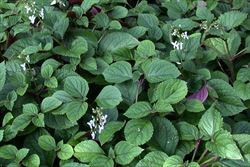Click on images to enlarge

infestation (Photo: Rob and Fiona Richardson)

habit prior to flowering (Photo: Rob and Fiona Richardson)

habit in flower (Photo: Rob and Fiona Richardson)

leaves (Photo: Rob and Fiona Richardson)

stem and paired leaves (Photo: Rob and Fiona Richardson)

close-up of younger leaves showing purplish underside (Photo: Rob and Fiona Richardson)

flower cluster (Photo: Rob and Fiona Richardson)

close-up of hairy stem and flowers (Photo: Rob and Fiona Richardson)
Scientific Name
Plectranthus ciliatus E. Mey.
Family
Labiatae (South Australia)Lamiaceae (Queensland, New South Wales, the ACT, Victoria, Tasmania, Western Australia and the Northern Territory)
Common Names
African spur flower, candle plant, candlestick plant, plectranthus, purple-leaved plectranthus, speckled spur flower, spur flower
Origin
Native to south-eastern Africa (i.e. eastern South Africa).
Naturalised Distribution
Naturalised in some parts of eastern Australia (i.e. in the coastal districts of central New South Wales, in southern Victoria and in south-eastern Queensland). It is mainly found near the urban centres of Sydney, Melbourne and Brisbane.
Notes
Purple-leaved plectranthus (Plectranthus ciliatus) is regarded as an environmental weed in Victoria and as a "sleeper weed" in other parts of eastern and southern Australia. This species was introduced as an ornamental and was first recorded as naturalised in New South Wales in 1972.
Purple-leaved plectranthus (Plectranthus ciliatus) is naturalised mainly in sandy soils, usually overlying sandstone, in the coastal districts of central New South Wales. It is frequently cultivated in the Sydney region and locally naturalised in native vegetation at Northbridge. It has also been recorded in conservation areas in New South Wales (e.g. Cooper Park in Woollahra Municipality Council and Jackson Park in Blue Mountains City Council).
In Victoria, this species was first recorded as naturalised at Lavers Hill in 1992. It is now much more widespread and is listed as a major environmental weed in Otway National Park, where a large infestation is present.
In New Zealand, where purple-leaved plectranthus (Plectranthus ciliatus) has been naturalised for a longer period of time, it is a more serious environmental weed. It is abundant throughout the North Island, but is much less common on the South Island. This species forms dense mats of vegetation along creeks, in forest margins, and in disturbed forests. Purple-leaved plectranthus (Plectranthus ciliatus) spreads rapidly to invade native bushland and has the capacity to deeply smother the forest floor, particularly along margins and in disturbed areas. It shades out seedlings and low-growing native species, eventually replacing them and preventing their establishment and growth. This can result in a change in the character of invaded areas.

